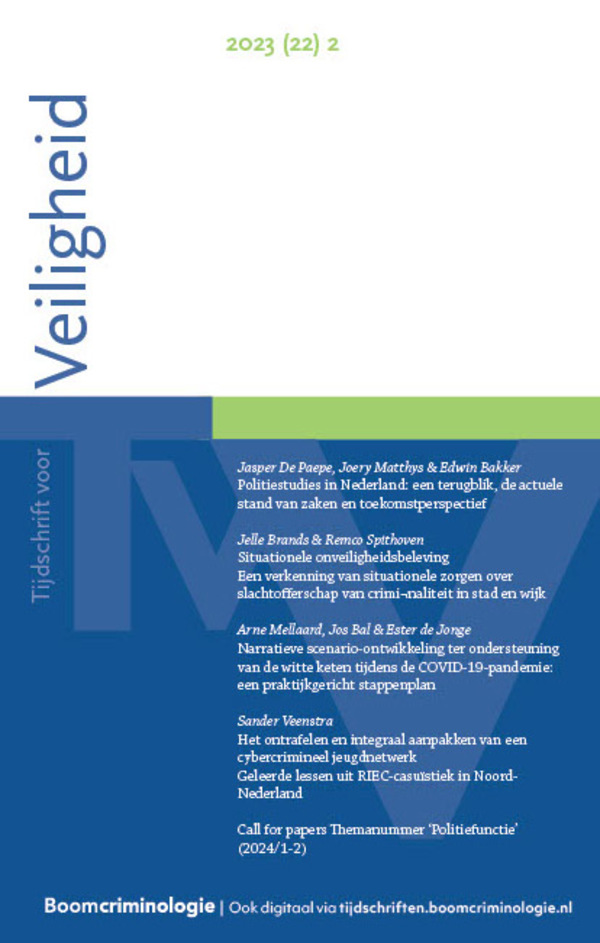|
The ‘fear of crime’ is a buzzword among citizens, media, politicians and professionals by now. But the phenomenon seems to be as intangible as it is important. The struggle of professionals with this concept is the result of a too wide and self-evident problem definition. This article contains an alternative approach. The focus is on disturbed fear of crime: a negatively changed and problematically experienced fear of crime on the level of the neighborhood. |


Tijdschrift voor Veiligheid
Meer op het gebied van Criminologie en veiligheid
Over dit tijdschriftMeld u zich hier aan voor de attendering op dit tijdschrift zodat u direct een mail ontvangt als er een nieuw digitaal nummer is verschenen en u de artikelen online kunt lezen.
| Artikel |
Verstoorde veiligheidsbelevingIn gesprek met buurtbewoners over de ‘onveiligheid’ in hun buurt naar aanleiding van gestegen ‘gevoelens van onveiligheid’ |
| Trefwoorden | fear of crime, qualitative analysis, evidence based policy |
| Auteurs | Remco Spithoven |
| SamenvattingAuteursinformatie |
| Artikel |
Veilig uitgaan: tegenstrijdige gevoelens over inzet politie en andere maatregelen |
| Trefwoorden | tegenstrijdigheden, assemblage, angst voor criminaliteit, uitgaansgebieden, veiligheidsbeleving |
| Auteurs | Jelle Brands en Irina van Aalst |
| SamenvattingAuteursinformatie |
|
Urban nightlife areas are widely renowned for their emotionally charged nature, affording greater opportunities for transgressions of social norms compared to daytime contexts. Yet, the ways nightlife consumers experience safety in the public spaces of nightlife areas has received limited attention in the academic literatures. This article approaches experienced safety in the public spaces of nightlife areas as emerging from encounters between human and non-human (material, social, cultural) elements grounded in time and space. Such elements include the characteristics of the built environment, the design of public space, police presence, lighting and also first and secondhand experiences and popular media discourses more generally. We hypothesized that encounters between such elements necessarily renders some ambiguity in experienced safety, in the sense that the effect of a particular element on experienced safety is always coproduced in the unfolding encounter. By drawing on a series of interviews with Dutch students in Utrecht, various types of ambiguity are shown to exist depending on both the particularities of the situation at hand and based on differences between individual circumstance and life course. Ambiguity is also shown to exist in the sense that mentioned elements may both comfort and alarm participants at the same time. Our findings infer that we should implement ‘safer nightlife’ initiatives that are tailored to particular contexts, situations and publics. The results also suggest that current interventions seeking to stimulate safety in urban nightlife settings might not be as successful in reducing/enhancing (un)safety as (popular) policy and media discourses have suggested. |
| Artikel |
Over preventief guardianship: er zijn is vaak genoeg |
| Trefwoorden | Guardianship, preventive guardianship, crime prevention, presence of bystanders, Evaluation |
| Auteurs | Henk Elffers |
| SamenvattingAuteursinformatie |
|
The most important mechanism for crime prevention is just the presence of guardians. Some counter arguments against this thesis are discussed and rejected. By manipulating the presence of guardians it is possible to influence the level of prevention. It is argued that a large scale evaluation of such measures is wanted. |
| Artikel |
Vechter buiten de ring; Narratief en biografie |
| Trefwoorden | Narratieve criminologie, Vechter, Biografie |
| Auteurs | Frank van Gemert |
| SamenvattingAuteursinformatie |
|
The most important mechanism for crime prevention is just the presence of guardians. Some counter arguments against this thesis are discussed and rejected. By manipulating the presence of guardians it is possible to influence the level of prevention. It is argued that a large scale evaluation of such measures is wanted. |
